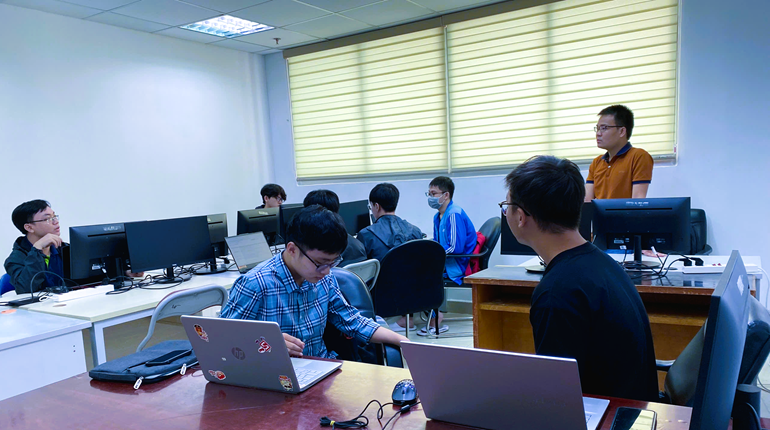 1. Digital Logic Families
1. Digital Logic Families
Logic families can be classified broadly according to the technologies they are built with. In earlier days we had vast number of these technologies, as you can see in the list below.
DL : Diode Logic.
RTL : Resistor Transistor Logic.
· DTL : Diode Transistor Logic.
· HTL : High threshold Logic.
· TTL : Transistor Transistor Logic.
· I2L : Integrated Injection Logic.
· ECL : Emitter coupled logic.
· MOS : Metal Oxide Semiconductor Logic (PMOS and NMOS).
· CMOS : Complementary Metal Oxide Semiconductor Logic.
Among these, only CMOS is most widely used by the ASIC (Chip) designers; we will still try to understand a few of the extinct / less used technologies. More in-depth explanation of CMOS will be covered in the VLSI section.
2. Content
Digital Logic Families Part-II
Digital Combinational Logic Part-III
Digital Combinational Logic Part-IV
Digital Combinational Logic Part-V
Digital Combinational Logic Part-VI
Digital Combinational Logic Part-VII
Basic Concepts
Before we start looking at the how gates are built using various technologies, we need to understand a few basic concepts. These concepts will go long way i.e. if you become a ASIC designer or Board designer, you may need to know these concepts very well.
- Fan-in.
- Fan-out.
- Noise Margin.
- Power Dissipation.
- Gate Delay.
- Wire Delay.
- Skew.
- Voltage Threshold.
Fan-in
Fan-in is the number of inputs a gate has, like a two input AND gate has fan-in of two, a three input NAND gate as a fan-in of three. So a NOT gate always has a fan-in of one. The figure below shows the effect of fan-in on the delay offered by a gate for a CMOS
based gate. Normally delay increases following a quadratic function of fan-in.
Fan-out
The number of gates that each gate can drive, while providing voltage levels in the guaranteed range, is called the standard load or fan-out. The fan-out really depends on the amount of electric current a gate can source or sink while driving other gates. The effects of loading a logic gate output with more than its rated fan-out has the following effects. |
- In the LOW state the output voltage VOL may increase above VOLmax.
- In the HIGH state the output voltage VOH may decrease below VOHmin.
- The operating temperature of the device may increase thereby reducing the reliability of the device and eventually causing the device failure.
- Output rise and fall times may increase beyond specifications
- The propagation delay may rise above the specified value.
Normally as in the case of fan-in, the delay offered by a gate increases with the increase in fan-out.
Gate Delay
Gate delay is the delay offered by a gate for the signal appearing at its input, before it reaches the gate output. The figure below shows a NOT gate with a delay of "Delta", where output X' changes only after a delay of "Delta". Gate delay is also known as propagation delay.
Gate delay is not the same for both transitions, i.e. gate delay will be different for low to high transition, compared to high to low transition.
Low to high transition delay is called turn-on delay and High to low transition delay is called turn-off delay.
Wire Delay
Gates are connected together with wires and these wires do delay the signal they carry, these delays become very significant when frequency increases, say when the transistor sizes are sub-micron. Sometimes wire delay is also called flight time (i.e. signal flight time from
point A to B). Wire delay is also known as transport delay.
Skew
The same signal arriving at different parts of the design with different phase is known as skew. Skew normally refers to clock signals. In the figure below, clock signal CLK reaches flip-flop FF0 at time t0, so with respect to the clock phase at the source, it has at FF0 input
a clock skew of t0 time units. Normally this is expressed in nanoseconds.
The waveform below shows how clock looks at different parts of the design. We will discuss the effects of clock skew later.
Logic levels
Logic levels are the voltage levels for logic high and logic low.
- VOHmin : The minimum output voltage in HIGH state (logic '1'). VOHmin is 2.4 V for TTL and 4.9 V for CMOS.
- VOLmax : The maximum output voltage in LOW state (logic '0'). VOLmax is 0.4 V for TTL and 0.1 V for CMOS.
- VIHmin : The minimum input voltage guaranteed to be recognised as logic 1. VIHmin is 2 V for TTL and 3.5 V for CMOS.
- VILmax : The maximum input voltage guaranteed to be recognised as logic 0. VILmax is 0.8 V for TTL and 1.5 V for CMOS.
Current levels
- IOHmin: The maximum current the output can source in HIGH state while still maintaining the output voltage above VOHmin.
- IOLmax : The maximum current the output can sink in LOW state while still maintaining the output voltage below VOLmax.
- IImax : The maximum current that flows into an input in any state (1µA for CMOS).
Noise Margin
Gate circuits are constructed to sustain variations in input and output voltage levels. Variations are usually the result of several different factors.
- drop
- High operating temperatures may cause a drift in transistor voltage and current characteristics
- Spurious pulses may be introduced on signal lines by normal surges of current in neighbouring supply lines.
- All these undesirable voltage variations that are superimposed on normal operating voltage levels are called noise. All gates are designed to tolerate a certain amount of noise on their input and output ports.
- The maximum noise voltag level that is tolerated by a gate is called noise margin. It derives from I/P-O/P voltage characteristic, measured under different operating conditions. It's normally supplied
from manufacturer in the gate documentation.
- LNM (Low noise margin): The largest noise amplitude that is guaranteed not to change the output voltage level when superimposed on the input voltage of the logic gate (when this voltage is in the LOW interval). LNM=VILmax-VOLmax.
- HNM (High noise margin): The largest noise amplitude that is guaranteed not to change the output voltage level if superimposed on the input voltage of the logic gate (when this voltage is in the HIGH interval). HNM=VOHmin-VIHmin
tr (Rise time)
The time required for the output voltage to increase from VILmax to VIHmin.
tf (Fall time)
The time required for the output voltage to decrease from VIHmin to VILmax.
tp (Propagation delay)
The time between the logic transition on an input and the corresponding logic transition on the output of the logic gate. The propagation delay is measured at midpoints.
Power Dissipation.
Each gate is connected to a power supply VCC (VDD in the case of CMOS). It draws a certain amount of current during its operation. Since each gate can be in a High, Transition or Low state, there are three different currents drawn from power supply.
- ICCH: Current drawn during HIGH state.
- ICCT: Current drawn during HIGH to LOW, LOW to HIGH transition.
- ICCL: Current drawn during LOW state.
For TTL, ICCT the transition current is negligible, in comparison to ICCH and ICCL. If we assume that ICCH and ICCL are equal then,
Average Power Dissipation = Vcc * (ICCH + ICCL)/2
For CMOS, ICCH and ICCL current is negligible, in comparison to ICCT. So the Average power dissipation is calculated as below.
Average Power Dissipation = Vcc * ICCT.
So for TTL like logics family, power dissipation does not depend on frequency of operation, and for CMOS the power dissipation depends on the operation frequency.
Power Dissipation is an important metric for two reasons. The amount of current and power available in a battery is nearly constant. Power dissipation of a circuit or system defines battery life: the greater the power dissipation, the shorter the battery life.
Power dissipation is proportional to the heat generated by the chip or system; excessive heat dissipation may increase operating temperature and cause gate circuitry to drift out of its normal operating range; will cause gates to generate improper output values.
Thus power dissipation of any gate implementation must be kept as low as possible.
Moreover, power dissipation can be classified into Static power dissipation and Dynamic power dissipation.
- Ps (Static Power Dissipation): Power consumed when the output or input are not changing or rather when clock is turned off. Normally static power dissipation is caused by leakage current. (As we reduce the transistor size, i.e. below 90nm, leakage current
- could be as high as 40% of total power dissipation).
- Pd (Dynamic Power Dissipation): Power consumed during output and input transitions. So we can say Pd is the actual power consumed i.e. the power consumed by transistors + leakage current.
Thus
Total power dissipation = static power dissipation + dynamic power dissipation
Decoders
A decoder is a multiple-input, multiple-output logic circuit that converts coded inputs into coded outputs, where the input and output codes are different; e.g. n-to-2n, BCD decoders
Enable inputs must be on for the decoder to function, otherwise its outputs assume a single "disabled" output code word.
Decoding is necessary in applications such as data multiplexing, 7 segment display and memory address decoding. Figure below shows the pseudo block of a decoder.
Basic Binary Decoder
And AND gate can be used as the basic decoding element, because its output is HIGH only when all its inputs are HIGH. For example, if the input binary number is 0110, then, to make all the inputs to the AND gate HIGH, the two outer bits must be inverted using two
inverters as shown in figure below.
Binary n-to-2n Decoders
A binary decoder has n inputs and 2n outputs. Only one output is active at any one time, corresponding to the input value. Figure below shows a representation of Binary n-to-2n decoder
Example - 2-to-4 Binary Decoder
A 2 to 4 decoder consists of two inputs and four outputs, truth table and symbols of which is shown below.
Truth Table
X | Y | F0 | F1 | F2 | F3 |
0 | 0 | 1 | 0 | 0 | 0 |
0 | 1 | 0 | 1 | 0 | 0 |
1 | 0 | 0 | 0 | 1 | 0 |
1 | 1 | 0 | 0 | 0 | 1 |
Symbol
To minimize the above truth table we may use kmap, but doing that you will realize that it is a waste of time. One can directly write down the function for each of the outputs. Thus we can draw the circuit as shown in figure below.
Note: Each output is a 2-variable minterm (X'Y', X'Y, XY', XY)
Example - 3-to-8 Binary Decoder
A 3 to 8 decoder consists of three inputs and eight outputs, truth table and symbols of which is shown below.
Truth Table
X | Y | Z | F0 | F1 | F2 | F3 | F4 | F5 | F6 | F7 |
0 | 0 | 0 | 1 | 0 | 0 | 0 | 0 | 0 | 0 | 0 |
0 | 0 | 1 | 0 | 1 | 0 | 0 | 0 | 0 | 0 | 0 |
0 | 1 | 0 | 0 | 0 | 1 | 0 | 0 | 0 | 0 | 0 |
0 | 1 | 1 | 0 | 0 | 0 | 1 | 0 | 0 | 0 | 0 |
1 | 0 | 0 | 0 | 0 | 0 | 0 | 1 | 0 | 0 | 0 |
1 | 0 | 1 | 0 | 0 | 0 | 0 | 0 | 1 | 0 | 0 |
1 | 1 | 0 | 0 | 0 | 0 | 0 | 0 | 0 | 1 | 0 |
1 | 1 | 1 | 0 | 0 | 0 | 0 | 0 | 0 | 0 | 1 |
Â
From the truth table we can draw the circuit diagram as shown in figure below.
Circuit
Implementing Functions Using Decoders
- Any n-variable logic function, in canonical sum-of-minterms form can be implemented using a single n-to-2n decoder to generate the minterms, and an OR gate to form the sum.
· The output lines of the decoder corresponding to the minterms of the function are used as inputs to the or gate.
- Any combinational circuit with n inputs and m outputs can be implemented with an n-to-2n decoder with m OR gates.
- Suitable when a circuit has many outputs, and each output function is expressed with few minterms.
Example - Full adder
Equation
S(x, y, z) = | ||||
C(x, y, z) = | ||||
Truth Table | ||||
X | Y | Z | C | S |
0 | 0 | 0 | 0 | 0 |
0 | 0 | 1 | 0 | 1 |
0 | 1 | 0 | 0 | 1 |
0 | 1 | 1 | 1 | 0 |
1 | 0 | 0 | 0 | 1 |
1 | 0 | 1 | 1 | 0 |
1 | 1 | 0 | 1 | 0 |
1 | 1 | 1 | 1 | 1 |
From the truth table we know the values for which the sum (s) is active and also the carry (c) is active. Thus we have the equation as shown above and a circuit can be drawn as shown below from the equation derived.
Encoders
An encoder is a combinational circuit that performs the inverse operation of a decoder. If a device output code has fewer bits than the input code has, the device is usually called an encoder. e.g. 2n-to-n, priority encoders.
The simplest encoder is a 2n-to-n binary encoder, where it has only one of 2n inputs = 1 and the output is the n-bit binary number corresponding to the active input
Example - Octal-to-Binary Encoder
Octal-to-Binary take 8 inputs and provides 3 outputs, thus doing the opposite of what the 3-to-8 decoder does. At any one time, only one input line has a value of 1. The figure below shows the truth table of an Octal-to-binary encoder.
Truth Table
I0 | I1 | I2 | I3 | I4 | I5 | I6 | I7 | Y2 | Y1 | Y0 |
1 | 0 | 0 | 0 | 0 | 0 | 0 | 0 | 0 | 0 | 0 |
0 | 1 | 0 | 0 | 0 | 0 | 0 | 0 | 0 | 0 | 1 |
0 | 0 | 1 | 0 | 0 | 0 | 0 | 0 | 0 | 1 | 0 |
0 | 0 | 0 | 1 | 0 | 0 | 0 | 0 | 0 | 1 | 1 |
0 | 0 | 0 | 0 | 1 | 0 | 0 | 0 | 1 | 0 | 0 |
0 | 0 | 0 | 0 | 0 | 1 | 0 | 0 | 1 | 0 | 1 |
0 | 0 | 0 | 0 | 0 | 0 | 1 | 0 | 1 | 1 | 0 |
0 | 0 | 0 | 0 | 0 | 0 | 0 | 1 | 1 | 1 | 1 |
For an 8-to-3 binary encoder with inputs I0-I7 the logic expressions of the outputs Y0-Y2 are:
Y0 = I1 + I3 + I5 + I7
Y1= I2 + I3 + I6 + I7 |
Y2 = I4 + I5 + I6 +I7
Based on the above equations, we can draw the circuit as shown below
Example - Decimal-to-Binary Encoder
Decimal-to-Binary take 10 inputs and provides 4 outputs, thus doing the opposite of what the 4-to-10 decoder does. At any one time, only one input line has a value of 1. The figure below shows the truth table of a Decimal-to-binary encoder.
Truth Table
I0 | I1 | I2 | I3 | I4 | I5 | I6 | I7 | I8 | I9 | Y3 | Y2 | Y1 | Y0 |
1 | 0 | 0 | 0 | 0 | 0 | 0 | 0 | 0 | 0 | 0 | 0 | 0 | 0 |
0 | 1 | 0 | 0 | 0 | 0 | 0 | 0 | 0 | 0 | 0 | 0 | 0 | 1 |
0 | 0 | 1 | 0 | 0 | 0 | 0 | 0 | 0 | 0 | 0 | 0 | 1 | 0 |
0 | 0 | 0 | 1 | 0 | 0 | 0 | 0 | 0 | 0 | 0 | 0 | 1 | 1 |
0 | 0 | 0 | 0 | 1 | 0 | 0 | 0 | 0 | 0 | 0 | 1 | 0 | 0 |
0 | 0 | 0 | 0 | 0 | 1 | 0 | 0 | 0 | 0 | 0 | 1 | 0 | 1 |
0 | 0 | 0 | 0 | 0 | 0 | 1 | 0 | 0 | 0 | 0 | 1 | 1 | 0 |
0 | 0 | 0 | 0 | 0 | 0 | 0 | 1 | 0 | 0 | 0 | 1 | 1 | 1 |
0 | 0 | 0 | 0 | 0 | 0 | 0 | 0 | 1 | 0 | 1 | 0 | 0 | 0 |
0 | 0 | 0 | 0 | 0 | 0 | 0 | 0 | 0 | 1 | 1 | 0 | 0 | 1 |
Y3 = I8 + I9 | |||||||||||||
Y2 = I4 + I5 + I6 + I7 | |||||||||||||
Y1 = I2 + I3 + I6 + I7 | |||||||||||||
Y0 = I1 + I3 + I5 + I7 + I9 | |||||||||||||
Priority Encoder
If we look carefully at the Encoder circuits that we got, we see the following limitations. If more then two inputs are active simultaneously, the output is unpredictable or rather it is not what we expect it to be.
This ambiguity is resolved if priority is established so that only one input is encoded, no matter how many inputs are active at a given point of time. |
The priority encoder includes a priority function. The operation of the priority encoder is such that if two or more inputs are active at the same time, the input having the highest priority will take precedence.
Example - 4to3 Priority Encoder
The truth table of a 4-input priority encoder is as shown below. The input D3 has the highest priority, D2 has next highest priority, D0 has the lowest priority. This means output Y2 and Y1 are 0 only when none of the inputs D1, D2, D3 are high and only D0 is high.
A 4 to 3 encoder consists of four inputs and three outputs, truth table and symbols of which is shown below.
Truth Table
D3 | D2 | D1 | D0 | Y2 | Y1 | Y0 |
0 | 0 | 0 | 0 | 0 | 0 | 0 |
0 | 0 | 0 | 1 | 0 | 0 | 1 |
0 | 0 | 1 | x | 0 | 1 | 0 |
0 | 1 | x | x | 0 | 1 | 1 |
1 | x | x | x | 1 | 0 | 0 |
Now that we have the truth table, we can draw the Kmaps as shown below. | ||||||
From the Kmap we can draw the circuit as shown below. For Y2, we connect directly to D3.
We can apply the same logic to get higher order priority encoders.
Multiplexer
A multiplexer (MUX) is a digital switch which connects data from one of n sources to the output. A number of select inputs determine which data source is connected to the output. The block diagram of MUX with n data sources of b bits wide and s bits wide select line
is shown in below figure. MUX acts like a digitally controlled multi-position switch where the binary code applied to the select inputs controls the input source that will be switched on to the output as shown in the figure below. At any given point of time only one input gets
selected and is connected to output, based on the select input signal.
Mechanical Equivalent of a Multiplexer
The operation of a multiplexer can be better explained using a mechanical switch as shown in the figure below. This rotary switch can touch any of the inputs, which is connected to the output. As you can see at any given point of time only one input gets transferred to output.
Example - 2x1 MUX
A 2 to 1 line multiplexer is shown in figure below, each 2 input lines A to B is applied to one input of an AND gate. Selection lines S are decoded to select a particular AND gate. The truth table for the 2:1 mux is given in the table below.
Symbol
Truth Table
| ||||||
Design of a 2:1 Mux | ||||||
To derive the gate level implementation of 2:1 mux we need to have truth table as shown in figure. And once we have the truth table, we can draw the K-map as shown in figure for all the cases when Y is equal to '1'. |
Combining the two 1' as shown in figure, we can drive the output y as shown below
Y = A.S' + B.S | |||
Truth Table | |||
B | A | S | Y |
0 | 0 | 0 | 0 |
0 | 0 | 1 | 0 |
0 | 1 | 0 | 1 |
0 | 1 | 1 | 0 |
1 | 0 | 0 | 0 |
1 | 0 | 1 | 1 |
1 | 1 | 0 | 1 |
1 | 1 | 1 | 1 |
Kmap
Example : 4:1 MUX
A 4 to 1 line multiplexer is shown in figure below, each of 4 input lines I0 to I3 is applied to one input of an AND gate. Selection lines S0 and S1 are decoded to select a particular AND gate. The truth table for the 4:1 mux is given in the table below.
Symbol
Truth Table
S1 | S0 | Y |
0 | 0 | I0 |
0 | 1 | I1 |
1 | 0 | I2 |
1 | 1 | I3 |
Circuit
Larger Multiplexers
Larger multiplexers can be constructed from smaller ones. An 8-to-1 multiplexer can be constructed from smaller multiplexers as shown below.
Example - 8-to-1 multiplexer from Smaller MUX
Truth Table
S2 | S1 | S0 | F |
0 | 0 | 0 | I0 |
0 | 0 | 1 | I1 |
0 | 1 | 0 | I2 |
0 | 1 | 1 | I3 |
1 | 0 | 0 | I4 |
1 | 0 | 1 | I5 |
1 | 1 | 0 | I6 |
1 | 1 | 1 | I7 |
Bạn Có Đam Mê Với Vi Mạch hay Nhúng - Bạn Muốn Trau Dồi Thêm Kĩ Năng
Mong Muốn Có Thêm Cơ Hội Trong Công Việc
Và Trở Thành Một Người Có Giá Trị Hơn
Mong Muốn Có Thêm Cơ Hội Trong Công Việc
Và Trở Thành Một Người Có Giá Trị Hơn
















